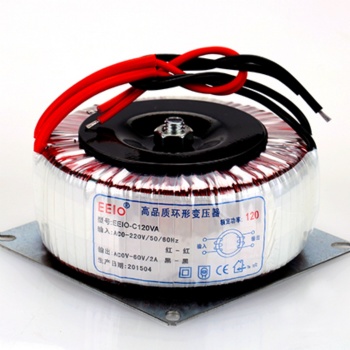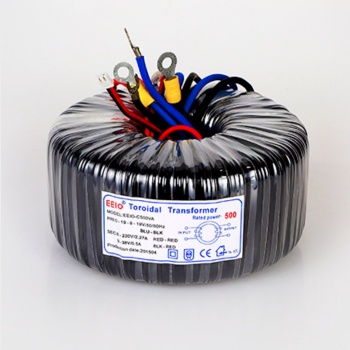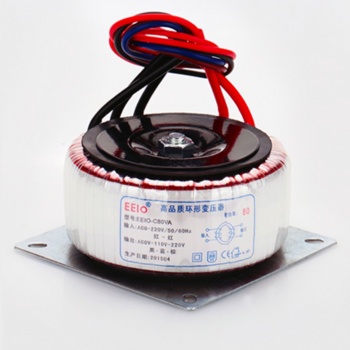News
EEIO Transformer Analyzes The Advantages and Disadvantages of Transformers in Audio Amplifiers
EEIO Transformer Analyzes The Advantages and Disadvantages of Transformers in Audio Amplifiers
The common power supply in audio amplifiers is generally composed of an industrial frequency transformer with rectifier and filter components. From the perspective of magnetic circuit structure, the commonly used transformers are mainly E-type transformers, toroidal transformers, C-type transformers and R-type transformers.
EI type is commonly used and common, with a simple structure. Its advantages are easy processing and winding, low cost, and good anti-saturation performance. The disadvantages are large magnetic leakage, large volume and weight under the same power, and relatively low conversion efficiency.
The sound trend of EI type transformers in terms of timbre is thick and rich, warm and mellow, and the sound field level and detail resolution are average.
When a special layered and segmented winding method is adopted (the so-called fever winding method), there is a significant improvement in details and resolution, and the fine extension of high frequencies is also excellent, which is different from other types of power transformers. If some auxiliary improvement measures are added to its shortcomings during use, such as adding a shielding cover, using high-quality iron cores and oxygen-free copper wires, and scientific and reasonable winding methods, this most primitive and ancient electronic device is still very outstanding.
The toroidal transformer is a variety developed after the C-type transformer. It has a short magnetic circuit, high efficiency, and copper and iron losses are both smaller than those of the EI-type transformer. It is small in size and weight and easy to install and use. The disadvantages are relatively high production costs and poor DC saturation resistance.
The toroidal transformer is refreshing, bright, and strong in tone, and its sound field level, detail resolution, and sense of speed are better than the EI type. However, it is inferior to the EI type in the thick sound and warmth of the mid-frequency. Because the toroidal transformer has some excellent performance characteristics, it is widely used in power amplifiers of various grades. However, due to the poor DC saturation resistance of the toroidal transformer, it is very easy to generate noise interference, so its application in some high-quality power amplifiers is subject to certain restrictions, especially some pure Class A power amplifiers. In recent years, due to technological advances, this inherent disadvantage of the toroidal transformer has been gradually improved, and the toroidal transformer has become more common in some high-end power amplifiers abroad.
The R-type transformer is a variety with better performance developed after the 1990s. The R-type transformer has all the advantages of the toroidal transformer:
1. The magnetic leakage is extremely small, only 1/10 of the EI-type transformer and about 1/5 of the C-type transformer.
2. Low loss and low temperature rise. The temperature rise is only 1/2 of the EI-type transformer at the same power.
3. Good frequency characteristics: The R-type transformer shows extremely small no-load current and no-load loss when working at the medium frequency (400Hz), and its order of magnitude can even reach the value when working at 50Hz; when the R-type transformer works in the audio range, it shows better amplitude-frequency characteristics than any other type of transformer: voltage waveform distortion <0.2%, frequency response <1dB. The disadvantage of the R-type transformer is the same as that of the toroidal transformer, and its anti-DC saturation performance is poor! Secondly, the current market price is still relatively expensive. At the same power, its price is twice that of the EI type, and it is more than 1/3 more expensive than the toroidal type.
The R-type transformer has a very full and solid sound, the instrument texture is very good, and it has better resolution and transients than the toroidal transformer. The low frequency has a clearer layered performance than other transformers. But the sound is colder, the sound is lighter, and the mid-frequency is relatively thin. The low-frequency volume seems to be less than that of the toroidal transformer with the same power. The diving depth is also not as good.
At the same time, due to the physiological defects of the structure, the R-type transformer has worse anti-DC saturation performance.
Since the iron core cannot be seen from the outside, it is difficult to directly judge the quality from the appearance. The quality of toroidal transformers on the market varies. Many products are just for show. They look very strong and powerful, but the actual use effect is very poor. However, since the iron core of E-type, C-type and R-type transformers is exposed, the quality is easier to grasp. Especially for C-type and R-type transformers, the overall cost is higher because the iron core manufacturing process is more complicated.
Regarding the iron core of the transformer, many people don’t care much about it. They feel that the iron core is similar. They only look at the power and buy it. The iron core directly determines the iron loss of the transformer and affects the sound quality. The heat treatment process of imported iron core materials is better than that of domestic ones.
EEIO transformers use imported iron cores and are wound with pure copper wire. They have been focusing on the production of toroidal transformers for 8 years. Both their quality and craftsmanship are superior to those of their peers.
Tag: Toroidal Transformer | Transformer
Categories
Contact Us
- 0086 13923119482
- info@eeiotransformer.com
- 0086 13923119482



